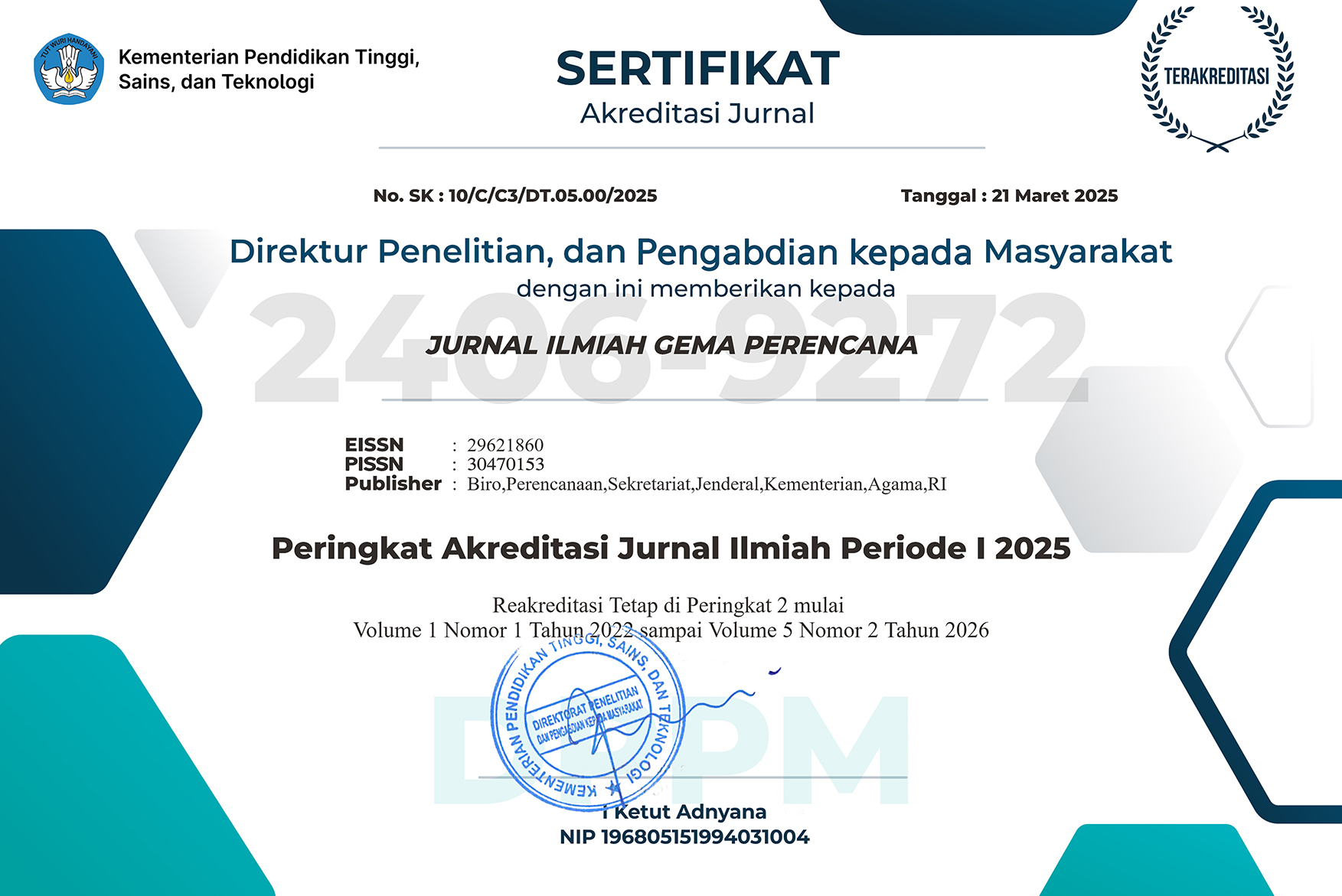Implementation of the One Stop Service Model at the Integrated Hajj and Umrah Service Center: A Policy Review and Its Impact on Hajj Pilgrim Satisfaction
DOI:
https://doi.org/10.61860/jigp.v4i2.280Abstract
This policy document discusses efforts to improve "One Stop Service" for Hajj pilgrims at the Integrated Hajj and Umrah Service Centers (PLHUT). The main problem identified is the inconsistent implementation of Standard Operating Procedures (SOPs) across the PLHUTs. This inconsistency stems from several factors, including: (1) low digital literacy among pilgrims, particularly the elderly, which hinders service effectiveness despite the existence of digital systems; (2) limited human resources, budget, modules, time, and manasik guidance facilities; and (3) the complexity of service flows and multi-agency bureaucracy involving many parties (such as the Ministry of Religious Affairs and banks). Furthermore, the absence of regulations requiring banks receiving deposits to occupy PLHUT buildings also hinders the implementation of "One Stop Service." This document uses an Urgency, Seriousness, Growth (USG) analysis and finds that inconsistent SOP implementation is the most fundamental problem that needs to be prioritized. The root of the problem is identified as a hierarchical and non-service-focused organizational design, as well as the complexity of the multi-agency bureaucracy. Based on an analysis of bureaucratic theory, open systems, and collaboration, and supported by laws and regulations, this document offers several policy alternatives. Based on William N. Dunn's criteria analysis, the most recommended alternative is to formulate Technical Guidelines/Instructions for the Implementation of Integrated Digital Services (Single Window Hajj-Umrah). This recommendation aims to create effective, transparent, and responsive services through an integrated digital system, which is expected to address SOP inconsistencies, integrate data across agencies, and improve overall service quality.
Downloads
References
Agranoff, R., & McGuire, M. (2003). Collaborative public management: New strategies for local governments. Georgetown University Press.
Ansell, C., & Gash, A. (2008). Collaborative governance in theory and practice. Journal of Public Administration Research and Theory, 18(4), 543–571. https://doi.org/10.1093/jopart/mum032
Bardach, E., & Patashnik, E. M. (2020). A practical guide for policy analysis: The eightfold path to more effective problem solving (6th ed.). CQ Press.
Bovaird, T., & Löffler, E. (2016). Public management and governance (3rd ed.). Routledge. https://doi.org/10.4324/9781315771986
Bryson, J. M. (2018). Strategic planning for public and nonprofit organizations: A guide to strengthening and sustaining organizational achievement (5th ed.). Jossey-Bass.
Denhardt, J. V., & Denhardt, R. B. (2015). The new public service: Serving, not steering (4th ed.). Routledge. https://doi.org/10.4324/9781315709781
Dunn, W. N. (2018). Public policy analysis: An integrated approach (6th ed.). Routledge. https://doi.org/10.4324/9781315632751
Dwiyanto, A. (2018). Reformasi birokrasi kontekstual: Implementasi dan tantangan. Gadjah Mada University Press.
Grindle, M. S., & Hilderbrand, M. E. (1995). Building sustainable capacity in the public sector: What can be done? Public Administration and Development, 15(5), 441–463. https://doi.org/10.1002/pad.4230150502
Huda, N. (2022). Manajemen keuangan syariah dan pengelolaan dana haji di Indonesia. Prenadamedia Group.
Juran, J. M., & Godfrey, A. B. (2010). Juran's quality handbook: The complete guide to performance excellence (6th ed.). McGraw-Hill Education.
Kementerian Agama Republik Indonesia. (2020). Standar operasional prosedur (SOP) Pusat Layanan Haji dan Umrah Terpadu. Direktorat Jenderal Penyelenggaraan Haji dan Umrah.
Kementerian Agama Republik Indonesia. (2023). Laporan kinerja Direktorat Jenderal Penyelenggaraan Haji dan Umrah.
Kementerian Agama Republik Indonesia. (2019). Peraturan Menteri Agama Republik Indonesia Nomor 13 Tahun 2019 tentang Penyelenggaraan Ibadah Haji Reguler. https://peraturan.bpk.go.id
Kementerian Pendayagunaan Aparatur Negara dan Reformasi Birokrasi Republik Indonesia. (2017). Peraturan Menteri PANRB Nomor 14 Tahun 2017 tentang Pedoman Penyusunan Survei Kepuasan Masyarakat. https://peraturan.bpk.go.id
Kementerian Pendayagunaan Aparatur Negara dan Reformasi Birokrasi Republik Indonesia. (2022). Roadmap reformasi birokrasi 2020–2024.
Kettunen, P., & Kallio, J. (2021). Responsiveness in public services: A systematic literature review. Public Management Review, 23(5), 712–734. https://doi.org/10.1080/14719037.2019.1699948
Kim, S. (2010). Public service motivation and organizational citizenship behavior in Korea. International Journal of Manpower, 31(7), 722–740. https://doi.org/10.1108/01437721011081652
Lipsky, M. (2010). Street-level bureaucracy: Dilemmas of the individual in public services (30th anniversary expanded ed.). Russell Sage Foundation.
Ndou, V. (2004). E–Government for developing countries: Opportunities and challenges. The Electronic Journal on Information Systems in Developing Countries, 18(1), 1–24. https://doi.org/10.1002/j.1681-4835.2004.tb00117.x
OECD. (2019). Government at a glance 2019. OECD Publishing. https://doi.org/10.1787/8ccf5c38-en
Ombudsman Republik Indonesia. (2022). Laporan hasil pengawasan pelayanan publik penyelenggaraan haji. Ombudsman RI.
Osborne, S. P., Radnor, Z., & Nasi, G. (2013). A new theory for public service management? Toward a (public) service-dominant approach. American Review of Public Administration, 43(2), 135–158. https://doi.org/10.1177/0275074012466935
Osborne, S. P. (2021). Public service logic: Creating value for public service users, citizens, and society through public service delivery. Routledge. https://doi.org/10.4324/9781003110730
Parasuraman, A., Zeithaml, V. A., & Berry, L. L. (1988). SERVQUAL: A multiple-item scale for measuring consumer perceptions of service quality. Journal of Retailing, 64(1), 12–40.
Prajogo, D., Toy, J., Bhattacharya, A., Oke, A., & Cheng, T. (2018). The relationships between information management, process management and operational performance: Internal and external contexts. International Journal of Production Economics, 199, 95–103. https://doi.org/10.1016/j.ijpe.2018.02.019
Rahmawati, D. (2024). Evaluasi implementasi pelayanan haji berbasis OSS di tingkat daerah. UIN Press.
Renn, O. (2008). Risk governance: Coping with uncertainty in a complex world. Earthscan.
Subarsono, A. G. (2011). Analisis kebijakan publik: Konsep, teori dan aplikasi. Pustaka Pelajar.
Sugiyono. (2019). Metode penelitian kuantitatif, kualitatif, dan R&D. Alfabeta.
United Nations. (2020). E-Government Survey 2020: Digital government in the decade of action for sustainable development. United Nations Department of Economic and Social Affairs. https://publicadministration.un.org/egovkb
UNESCAP. (2009). What is good governance?. United Nations Economic and Social Commission for Asia and the Pacific.
Walker, W., Haasnoot, M., & Kwakkel, J. (2013). Adapt or perish: A review of planning approaches for adaptation under deep uncertainty. Sustainability, 5(3), 955–979. https://doi.org/10.3390/su5030955
Wawasan BDK Jakarta. (2018). Desain organisasi publik dan tantangan birokrasi pelayanan. Balai Diklat Keagamaan Jakarta.
Weimer, D. L., & Vining, A. R. (2017). Policy analysis: Concepts and practice (6th ed.). Routledge. https://doi.org/10.4324/9781315442176
World Bank. (2016). Doing business 2016: Measuring regulatory quality and efficiency. World Bank Group. https://doi.org/10.1596/978-1-4648-0667-4
World Bank. (2018). One-stop shops for services. World Bank Group.
Downloads
Published
How to Cite
Issue
Section
License
Copyright (c) 2025 Zainar Inayah

This work is licensed under a Creative Commons Attribution 4.0 International License.








